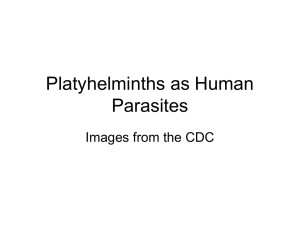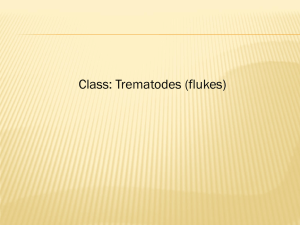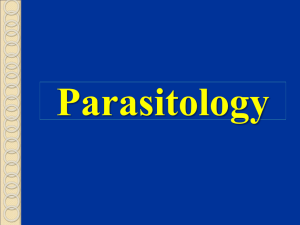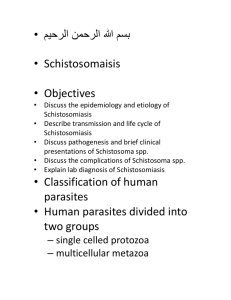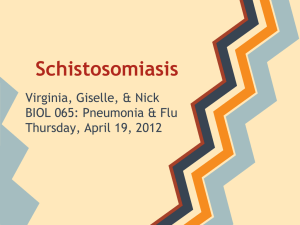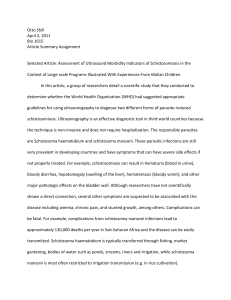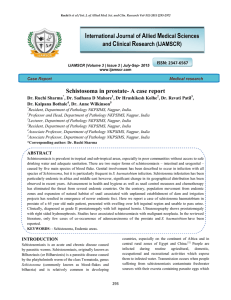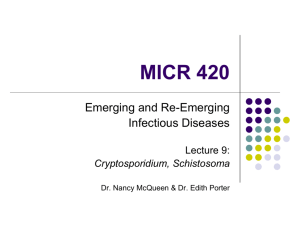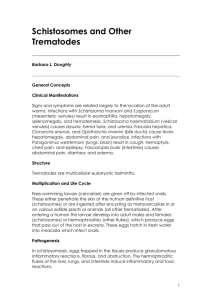Tapeworms & Flukes: Life Cycle, Disease & Treatment
advertisement
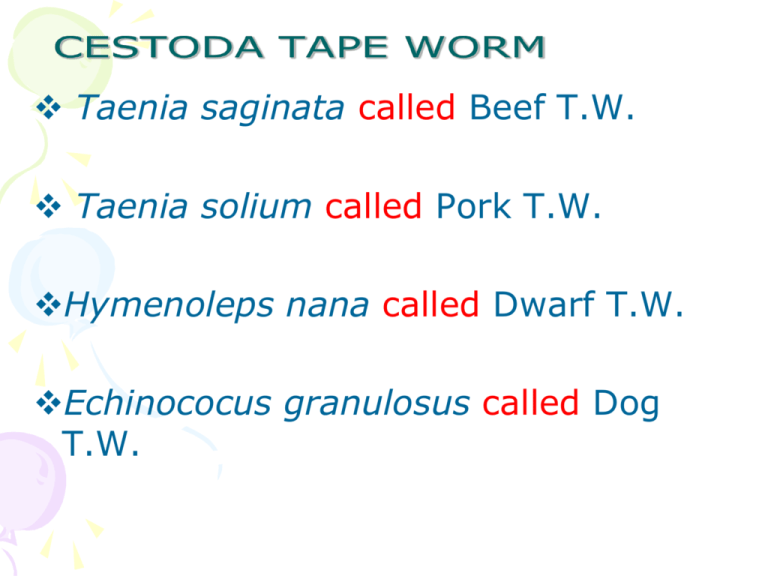
Taenia saginata called Beef T.W. Taenia solium called Pork T.W. Hymenoleps nana called Dwarf T.W. Echinococus granulosus called Dog T.W. 3-Hymenolepis nana→ Dwarf Tapeworm. Common name→→ called the Dwarf tapeworm. Adult worm is only 10-45 mm long and 0.5-1 mm wide, Disease→ Dwarf tapeworm infection or Hymenolepiasis . Widely distribution in children and most common. Infective stage to human is called →ova by food and water. Mode of infection →1-contaminated food and water with ova or 2- Auto infection, ova remains and hatches in the intestine. Rout of infection →Mouth. Habitat→ Adult worm in the small intestine of human. Life cycle is direct no intermediate host. Symptoms Rare symptoms include anorexia, vomiting, nausea and behavioral disturbances. Control → Avoid taken contaminated food and water. Diagnosis find →ova and gravid segment in stool. Treatment → Praziquantel is the drug of choice. 4-Echinococcus granulosus→Dog Tapeworm. Common name→ is called the dog tapeworm. Disease →→Dog tapeworm infection in dogs or Hydatidosis in (I.host). It is world wide specially in dogs regions. Infective stage to human and cattle is called →ova by food and water. Mode of infection →contaminated food and water with ova. Rout of infection →mouth. Intermediate host→ human, sheep cattle, camels all carry hydatid cyst. Larval stage is hydatid cyst in intermediate host. Habitat→ adult worm in the small intestine of dogs. Final host →is only the dogs . Symptoms Rare symptoms because the cyst grow slowly unless it rupture causing Anaphylactic shock due to release of protoscolices and toxins of hydatid cyst. Control → Avoid taken contaminated food and water. keep the dogs away with human contact. Diagnosis → Mostly X RAY OR CT SCAN OR ULTRASOUND to find the cyst. Treatment → surgical intervention most common(90%) ALBENDAZOLE DRUG OF CHOICE. Echinococcus granulosus L.C Class Trematoda: • Trematodes are commonly referred to or commonly called as flukes. • All are hermaphrodite (except→ Schistosoma in which sexes are separated). • All of them are parasitic and pathogenic flatworms. • Body has 2 oral & ventral suckers (except some species have 3rd genital sucker). • • Oral suckers Situated anteriorly sometimes supported by hooks. Ventral sucker on ventral side for attachment and fixation. • Life cycle→ all have indirect needs snails as (I.H)and vertebrates as final host, Show sexual stages or adult stages in the (definitive host) and asexual or larval stages in the (I.H.). • The habitat either in blood called blood flukes or in intestine called intestinal flukes or in the liver called hepatic or liver flukes. Genus Schistosoma • G:Schistosoma, commonly known as blood-flukes and bilharzia causing schistosomiasis. • Adult parasitize and lives in blood vessels. • They are dioecious(sexes are separated) • All Schistosoma has indirect life cycle. • It needs I.H(Snail)→larval immature stages. • It needs human as final host→ adult stage. • Male has ventral groove called a gynecophoric canal that extented posterior to the ventral sucker that holds female during copulation. Genus: Schistosoma species • Common name. Blood flukes, Bilharzias worm • Schistosoma, (phylum Platyhelminthes), three members of which are well known for causing the disease schistosomiasis in humans. • Three pathogenic Spps to human: • 1-S. haematobium→→ causes schistosomal hematuria, vesical schistosomiasis, and urinary bilharziasis. • 2-S. mansoni→→ causes intestinal bilharziasis, schistosomiasis mansoni. • 3-S. japonicum→→ causes Oriental schistosomiasis or Katayama disease. ADULTS of schistosoma. ↓Oral sucker ↑ Ventral sucker Schistosoma haematobium • Schistosoma haematobium • Common name→→ Urinary blood flukes. • Disease →→Schistosomal hematuria, vesicle schistosomiasis, and urinary B. • Infective stage →→Bi-forked tail cercaria. • Mode of infection →→skin penetration. • Intermediate host→→ Snail called Bulinus spp • Final or definitive host →→Human. • Habitat →→Venous or vesicle plexus of urinary bladder. • Egg →→Oval in shape with terminal spine. • Diagnostic stage→→ ova with terminal spine in urine. ↑↑contact water↓↓ Biforked tailed cercaria Symptoms and Diagnosis • Symptoms: • Penetration of cercariae causes dermatitis. • (Painless haematuria) from ulcer of the U.Bladder. • Difficulty in urinatination. • In females, vulva, vagina, cervix, ovaries, may be infected. • The loss of blood can lead to iron deficiency anemia. • Secondary infections, kidney damage, and even cancer Diagnosis: • GUE for Detection of ova specially in last few drops of urine. Prophylaxis and treatment • Prophylaxis: • Prevention of pollution of H2o in rivers with human urine. • Eradication of I.H. (Mollusks). • Avoiding swimming or washing, or bathing in or contact with infected or polluted water. • Decrease the infected person by medical drugs. Treatment. • The usage of medications against schistosomiasis, • praziquantel is the drug of choice for treatment

